#september 1872
Explore tagged Tumblr posts
Text

#september 1872#1872#1870s#edith mary liddel#alice liddel#lorina liddel#photographer: julia margaret cameron#edith mary liddel 1870s#alice liddel 1870s#lorina liddel 1870s
0 notes
Text

La Mode illustrée, no. 36, 8 septembre 1872, Paris. Manteau-écharpe. Pardessus de demi-saison. Ville de Paris / Bibliothèque Forney
#La Mode illustrée#19th century#1870s#1872#on this day#September 8#periodical#fashion#fashion plate#Forney#dress#mantle#coat#stripes
27 notes
·
View notes
Text



On September 23, 1872, the Rockefeller Fountain was turned on in Como, Italy.
#Rockefeller Fountain by Biagio Catella#turned on#23 September 1872#Bronx Zoo#the Bronx#New York City#summer 2018#travel#original photography#vacation#tourist attraction#landmark#architecture#cityscape#USA#US history#anniversary#public art#lawn#nature#flora
3 notes
·
View notes
Text
‼️ I FINISHED MAKING BIRTHDAYS FOR THE RDR2 GANG‼️ (under the cut)
these are my own personal headcanon (with some help from the comments) so take with a grain of salt, we may have different interpretations
(source for all traits is zodiacsign.com)
DUTCH VAN DER LINDE
- Founding member, for 23 years (1876, when he was 21)
- 44 in May 1899
- Born April 11th 1855 (Aries)
Positive Apr 11th traits: “Assertive, strong and remarkably passionate, they will burn every obstacle in their way if they have something to strive for. They are excellent workers and managers, showing initiative with just enough tact to be loved by a team they work in.”
Negative Apr 11th traits“Preoccupied with their own problems, they could fail to see what their friends and close people are going through. Self-centered, too feisty, ready for battle when it isn't necessary, reactive, and sometimes aggressive when they should remain calm.”
HOSEA MATTHEWS
- Founding member, for 23 years (since 1876, when he was 32)
- 55 in May 1899
- Born October 22nd 1843 (Libra)
Positive Oct 22nd traits: “Warm, open for emotional contact, and nurturing, they are tender and kind to those they love and treat everyone with enough empathy to resolve issues at hand. Their emotional sensitivity is their greatest strength.”
Negative Oct 22nd traits: “Covered in sadness, broken and depressed, they might lose faith if they don’t give themselves time to rest and regenerate from past experiences. Tied by stories of their ancestors, they could simply play parts of others without getting truly invested in their own life and their happiness.”
ARTHUR MORGAN
- In gang for 23 years (since 1876,when he was 13)
- 36 in May 1899
- Born September 30th 1862 (Libra)
Positive Sep 30th traits: “Truthful, powerful, deep and ready to commit to issues that are too painful for other people, they have the power to change the unchangeable and build a sense of magic in their life that allows them to attract and control their own destiny and heal others of prejudice.”
Negative Sep 30th traits: “Depressed or lost in what they’ve been taught, they could be too scared to get out of their usual directions and choices in life, getting stuck in mental activities that keep them unsatisfied, egocentric or grumpy.”
SUSAN GRIMSHAW
- In the gang for 14 years (since 1885, since she was 29)
- 45 in 1899
- Born March 27th 1854 (Aries)
Positive Mar 27th traits: “Standing out, innovative and wide in perception of the world, they are good friends and tend to build a social circle that can support them in their path. Free to shine and give freedom to other people.”
Negative Mar 27th traits: “Stressed, torn between extremes, their mood changes without warning. They can get aggressive if too much anger builds up, unsure how they will react or what their next move will be.”
JOHN MARSTON
- In gang for 14 years (since 1885, when he was 12)
- 26 in May 1899
- Born August 3rd 1872 (Leo)
Positive Aug 3rd traits: “Straightforward, on the move, and wide in their opinions, they are the travelers with a cause, those who share their views and their knowledge selflessly, and wish to give their energy to those willing to follow.”
Negative Aug 3rd traits: “Stubbornly chasing after things that aren’t real, they could get stuck in a loop of disappointment and mental efforts that won’t lead them where they wish to go.”
SIMON PEARSON
- In the gang for 13 years (since 1886, since he was 35)
- 48 in 1899
- Born December 16th 1850 (Sagittarius)
Positive Dec 16th traits: “Laughter, positivity, and a fun personality ordain those born on December 16th for as long as they are in tune with their talents. Emotionally charged, they stay on the move, give love to be loved, and understand how to create balance when they find themselves falling into an extreme.”
Negative Dec 16th traits: “Lost in confusion of relating with others, they absorb atmospheres, feelings and ultimately opinions of others, thinking that their personality is defined by what others see instead of feeling their own core of Self.”
LEOPOLD STRAUSS
- In the gang for 12 years (since 1887, since he was 41)
- 53 in 1899
- Born in September 10th 1845 (Virgo)
Positive Sep 10th trait: “Deep, intelligent and extremely powerful, they are focused and dedicated to the higher truth and find change satisfying, without fear of what tomorrow might bring. They bring order to large things in the lives of people around them and announce change everywhere they go.”
Negative Sep 10th traits: “Obsessive, possessive and jealous, they can get dismissive of other people's ways and unwilling to recognize their own shadows while judging others. When bruised, they may become vindictive or manipulative.”
UNCLE
- In the gang for 11 years (since 1888, since he was 43)
- 57 in 1899
- Born May 6th 1842 (Taurus)
Positive May 6th traits: “Loving, creative, good with children, they are positive individuals with a lot of energy to live life to the fullest. Humorous, smiling, and grounded, they search for a place to belong to and connect easily to other people.”
Negative May 6th traits: “Unaware of the bigger picture, too focused on problems when they become aware of them, they can get obsessive and go into negative details for days. At times superficial in search for pleasure, but only if their heart isn’t open for relating.”
JOSIAH TRELAWNY
- In the gang for 9 years (since 1890, since he was 31)
- 40 in 1899
- Born May 26 1859 (Gemini)
Positive May 26th traits: “Loving, emotional, kind and caring, they are the messengers of beauty and laughter, humorous enough to make a grown person turn into a little child if this is their intent.”
Negative May 26th traits: “Using the power of words for strange things, unsatisfied and unable to find balance between emotion and reason, they get lost waiting and thinking about times when they were actually free while missing opportunities to set free in the now.”
ORVILLE SWANSON
- In the gang for 8 years (since 1891, since he was 38)
- 46 in 1899
- Born November 29th 1852 (Sagittarius)
Positive Nov 29th traits: “Idealists with a cause, they dream big and aren’t afraid to try themselves out in talents that make them who they are. On the quest for inner truth, they are sensitive, empathic and honest about the way they feel with people they love.”
Negative Nov 29th traits: “Seeking attention and unable to untangle issues that keep them intoxicated or tied to the past, they could get lost, searching for ways to anesthetize that pain and forget what bruised them in the first place.”
BILL WILLIAMSON
- In the gang for 5 years (since 1894, since he was 28)
- 33 in May 1899
- Born in April 27th 1866 (Taurus)
Positive Apr 27th traits: “Strong-hearted individuals, filled with vigor and energy for things that make them feel passionate. They are different but social, well-incorporated into society, and make excellent friends who find humanitarianism and compassion to be everything that is right in the world.”
Negative Apr 27th traits: “Sloppy, unsure what they wish to do with their energy and frustrated with their own nature. In opposition to themselves, they are unable to heal their own inner differences, becoming frustrated and passively angry at other people.”
ABIGAIL ROBERTS
- In the gang for 5 years (since 1894, since she was 17)
- 22 in 1899
- Born October 20th 1876 (Libra)
Positive Oct 20th traits: “Deeply emotional and empathic, if they keep their heart open throughout changes in their life, they become healers and incredible support in times of crisis and all possibly dangerous situations in the lives of others.”
Negative Oct 20th traits: “Casting their feelings away, they could become cold, distant, too difficult to relate to, and vindictive. They need a strong foundation to grow from and won’t be at all pleasant if they don’t learn to regenerate and flow with the beat of their heart.”
KAREN JONES
- In the gang for 4 years (since 1895, since she was 21)
- 25 in 1899
- Born June 12th 1873 (Gemini)
Positive June 12th traits: “Emotional, sensitive, compassionate and willing to listen, they are less rational than other Gemini representatives and this gives them more space for relating and reaching for the Divine Love.”
Negative June 12th traits: “Moody, torn between different roles and too adaptable to people and situations that don’t make them feel good. They get self-destructive when unable to deal with their own emotional baggage.”
JAVIER ESCUELLA
- In the gang for 4 years (since 1895, since he was 22)
- 26 in May 1899
- Born August 13th 1872 (Leo)
Positive Aug 13th traits: “Energetic, focused visionaries, ready to act with initiative and clarity of ideals, they are the ones to fight for the cause and move forwards when others would stay behind. They are warm, passionate people, ready to learn new things and move one step ahead of the rest of the world.”
Negative Aug 3rd traits: “Feeling as if they were all mighty, they often get caught up in their own ambitions and strivings, expecting nothing less than perfect from their ways of expression and battles that might be impossible to win.”
JACK MARSTON
- In the gang for 4 years (since 1895, since he was born)
- 4 in May 1899
- Born November 7th 1894 (Scorpio) (tried to be based on RDR1 but i’ve never played it 😬)
Positive Nov 7th traits: “Innovative, groundbreaking, different and individualistic, they understand that their greatest quality hides in their special way of standing out. Reliable friends with a need to fight for the greater good, they are those who bring necessary changes into a dysfunctional system.”
Negative Nov 7th traits: “In their battles they might get lost, become aggressive and pushy, losing contact only to pursue information held in their mind. Their mental processes get detached from their heart, leading them into abusive states towards self and others when they should be simply flowing with the times.”
MARY-BETH GASKILL
- In the gang for 3 years (since 1896, since she was 20)
- 23 in May 1899
- Born March 3rd 1876 (Pisces)
Positive Mar 3rd traits: “Great learners, teachers, and healers, they find love and beauty in everything they see and touch. It is their talent to use their optimism and beliefs, and turn every negative thing and experience to art, acceptable fate, and a step to a brighter future.”
Negative Mar 3rd traits: “In denial, distant, lost, they can be wanderers that cannot find the right direction to move in. Their defense mechanism protecting them from hardship is delusion.”
TILLY JACKSON
- In the gang for 3 years (since 1896, since she was 17)
- 20 in May 1899
- Born February 18th 1879 (Aquarius)
Positive Feb 18th traits: “Passionate, creative, focused, and understanding, this is someone able to sense the moment when the leader is needed, bravely becoming one. Fast and fiery, on their search for emotion, they wish to stay open-hearted throughout their lifetime.”
Negative Feb 18th traits: “With boundaries shaken, they can dismiss emotions, becoming overly rational and turned to the practical future in front of them. Unaware of their own sensitivity and hurt they might have caused to other people.”
MOLLY O’SHEA
- In the gang for 2 years (since 1897, since she was 22)
- 24 in May 1899
- Born May 4th 1875 (Taurus)
Positive May 4th traits: “Dependable, organized, ambitious, and responsible, they are easy to work and plan a future with. Just and turned to values of interpersonal bonding that lead them towards ideals.”
Negative May 4th traits: “A bit dark, difficult, and stiff, they can be set in their mind and unable to change. Stuck in a moment, a relationship or a job that makes them unhappy, it is their imperative in life to find faith and let go to the pull of the Universe.”
SEAN MACQUIRE
- In the gang for 1 years (since 1898, since he was 25)
- 26 in May 1899
- Born July 23rd 1872 (Leo) (sign rec from anon)
Positive July 23rd traits: “Optimistic, with a fine sense of humor and ready to chase off any negative emotions with their smile, they are positive, loving and supportive of those they care for. Travelers and teachers, they have something important to give to the world.”
Negative 23rd traits: “Scattered and pushed by too many beliefs they never questioned, they tend to spin in circles of negative choices, lost in their inability to receive as much as they give away or vice versa.”
CHARLES SMITH
- In the gang for 9 months (Since August 1898, since he was 26)
- 27 in May 1899
- Born November 1st 1871 (Scorpio)
Positive Nov 1st traits: “Centered, standing firm on their identity and seeing the light in others, they make wonders in therapeutic and supportive relationships with those who are insecure and find it hard to stand confident on their own two feet. Strong-willed and ready to learn, they are the ones to lead the way when their beliefs are set in place.”
Negative Nov 1st traits: “Getting lost among strong individuals meant to inspire them, they give up on their true role due to lack of belief in their own emotional world and their personal convictions. This could get them lost and put their talents to waste out of the need to prove themselves worthy.”
LENNY SUMMERS
- In the gang for 9 months (since 1898, since he was 19)
- 19 in May 1899
- Born June 5th 1880 (Gemini)
Positive June 5th traits: “Childlike, curious, excited about life and focused on their daily sources of happiness, they are humorous and always with a nice thing to say in just the right moment.”
Negative June 5th traits: “In need of a different view, they could get stuck in patterns that don’t give much room for personal growth. If their hearts close, they become superficial and uncaring for the wellbeing of those who aren’t in their closest social circle.”
MICAH BELL
- In the gang for 4 months (Since december 1898)
- 39 in May 1899
- Born January 1 1860 (Capricorn)
Positive Jan 1st traits: “Powerful and resourceful individuals with an incredible potential for a successful life, influential and knowing exactly where they belong. They are assertive, strong-willed, with a deep understanding for natural development of any issue at hand.”
Negative Jan 1st traits: “Inventors and great minds that turn to solitude and separate from the ideal of emotional fulfillment. Manipulative, they may be using questionable methods to reach their goals.”
SADIE ADLER
- In the gang for a few months (since May 1899, since she was 25)
- 25 in May 1899
- Born July 4th 1873 (Cancer)
Positive July 4th traits: “Focused on their goal point, ambitions and understanding the consequences of their deeds, they are strong, endurable and extremely reliable as friends and confidants.”
Negative July 4th traits: “Dark and filled with depressing thoughts, they can get pulled by negative emotions, memories they don’t know how to metabolize, and nostalgic turns that pull them into harmful circumstances that weaken their boundaries.”
KIERAN DUFFY
- In the gang for a few months (since May 1899, since he was 28)
- 28 in May 1899
- Born January 20th 1871
Positive Jan 20th traits: “Compassionate, caring, sensitive and talented, this is someone who can create incredible things if emotionally supported by all the right people. Nurtures their inner child and cares for others greatly even when holding back instead of showing their affection.”
Negative Jan 20th traits: “Closed from the rest of the world, unable to find meaning in hurtful experiences from the past and questioning their vision daily, these individuals easily turn to destructive tendencies.”
THANK YOU FOR YOUR HELP ‼️
#rdr2#dutch van der linde#hosea matthews#arthur morgan#john marston#javier escuella#bill williamson#micah bell#charles smith#sean macguire#lenny summers#sadie adler#karen jones#tilly jackson#mary beth gaskill#uncle rdr2#abigail roberts#abigail marston#susan grimshaw#simon pearson#josiah trelawny#reverend swanson#jack marston#dutch van der linde x reader#arthur morgan x reader#john marston x reader#javier escuella x reader#charles smith x reader#kieran duffy x reader#kieran duffy
97 notes
·
View notes
Text

Title: September Fete, Pontoise
Artist: Camille Pissarro
Date: 1872
Style: Impressionism
Genre: Genre Painting
#art#art history#artwork#painting#history#museums#culture#vintage#curators#museum#camille pissarro#impressionism#genre painting
107 notes
·
View notes
Text
RDR Event Timeline (Canon + Headcanon)
This is the timeline I have constructed and use for all of my Red Dead writings. Canon event dates/ages are taken from the Red Dead Wiki, and headcanon estimations for more ambiguous events/characters are based on their approximate ages in-game by 1899 and what makes the most logical sense to me based on that timeline.
Please feel free to use this as a reference for your own works too, if it helps. (Canon events are noted as such, and my headcanons are labeled "HC.")
1839 - Uncle born (HC)
1844 - Hosea Matthews born (Canon)
1845 - Rains Fall born (HC)
1846 - Leopold Stauss born (HC)
1850 - Susan Grimshaw born (HC)
1853 - Orville Swanson born (HC)
1855 - Dutch Van der Linde born (Canon)
1857 - Josiah Trelawney born (HC)
1860 - Micah Bell III born (Canon) (newspaper clipping mentions Micah Bell Jr. robbing with his 17-year-old son in 1877)
1861 - Simon Pearson born (HC)
1863 - Arthur Morgan born (Canon)
1866 - Bill Williamson born (Canon)
1870 - Dutch leaves home aged 15 (Canon); Kieran Duffy born (HC)
1871 - Sadie Adler born (HC)
1872 - Charles Smith born (HC) (based on est. age of 27 in 1899)
1873 - John Marston born (Canon); Javier Escuella born (HC)
1874 - Lyle Morgan arrested and hanged, Arthur orphaned (Canon); Molly O'Shea born (HC)
1875 - Karen Jones born (HC)
1876 - Dutch and Hosea meet outside of Chicago, IL (Canon); Sean MacGuire born (HC)
1877 - Abigail Roberts born; Arthur joins the gang, aged 14 (Canon)
1878 - Eagle Flies born (HC)
1879 - Tilly Jackson and MaryBeth Gaskill born (HC)
1880 - Lenny Summers born (Canon)
1881 - John Marston's father dies, John orphaned (Canon)
1882- Annabelle and Bessie join the gang (HC)
1883 - Bessie and Hosea marry and leave the gang (Canon); Arthur meets and begins dating Mary Gillis (HC) (Jamie Gillis references both Annabelle and Bessie during the mission in Chapter 2, so IMO this would've been the most likely time for all 3 to have met one another.)
1884 - Dutch kills Colm O'Driscoll's unnamed brother, Annabelle killed by Colm in retaliation; Hosea returns to the gang (HC)
1885 - John Marston and Susan Grimshaw join the gang (Canon); Charles Smith leaves home, aged 13 (HC) (based on est. DOB 1872)
1886 - Arthur proposes to and subsequently breaks up with Mary in the springtime; Arthur meets Eliza (19) later in the year, and Isaac is conceived (HC)
1887 - Lee & Hoyt Bank Robbery, April (Canon); Isaac Morgan born (HC) (According to Arthur in-game, Eliza only knew who he was after she got pregnant. Based on this they most likely met in late 1886 or very early 1887, with the bank robbery in April '87 and Isaac born that autumn.)
1888 - Death of Bessie Matthews (HC) (based on the assumption that she passed some time before Arthur lost his son. Her cause of death is never specified in canon, but I HC it was a fairly quick battle with pneumonia over the winter.)
1891 - Isaac Morgan (4) and Eliza (23) killed in a home robbery (HC)
1892 - Bill Williamson dishonorably discharged from the U.S. Army (Canon); Uncle joins the gang (HC)
1893 - Bill Williamson joins the gang (Canon)
1894 - Abigail Roberts joins the gang, introduced to them by Uncle (Canon)
1895 - Jack Marston born; Javier joins the gang (Canon)
1896 - John Marston leaves the gang; Jake and Sadie Adler marry in September (Canon)
1897 - John Marston returns to the gang after a year (Canon)
1898 - Micah Bell, Charles Smith, Lenny Summers, and Jenny Kirk join the gang (Canon)
1899 - Blackwater Massacre; dissolving of the Van der Linde gang; deaths of Jenny Kirk, Mac and Davey Callender, Sean MacGuire, Kieran Duffy, Hosea Matthews, Lenny Summers, Molly O'Shea, Eagle Flies, Susan Grimshaw, and Arthur Morgan (Canon)
1907 - Construction of Beecher's Hope ranch; John and Abigail marry; death of Micah Bell III (Canon)
1911 - Kidnapping of Abigail and Jack Marston by the U.S. Government in exchange for John's cooperation; deaths of Bill Williamson, Javier Escuella, Dutch Van der Linde, Uncle, and John Marston (Canon)
1914 - Death of Abigail Marston; Jack Marston kills Edgar Ross to avenge his father's murder (Canon)

#rdr2#red dead redemption#red dead redemption 2#rdr#fanfiction#rdr fanfiction#rdr2 fanfiction#rdr fanfic#red dead redemption timeline#writing resources#canon compliant#heacanons#zanazirawrites
119 notes
·
View notes
Text

Norton's Birth Year and some facts about his age at the time of the DeRoss tragedy
Alice: age 6 when her parents die in the tragedy
Year of the tragedy: 1887, based on the Official Artbook
Alice is 21 in the final game, so the final game was in 1902.
Norton is 28 in the final game.
-> Norton was born in 1874 and age 12 on the day of the tragedy in 1887.
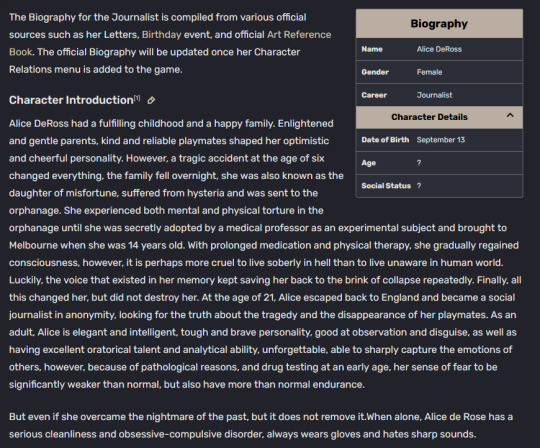
Alice's birthday: September 13.
If Alice is 6 during the tragedy, and the tragedy was in 1887, that tragedy had to have happened between September 13, 1887 and December 31, 1887.
Norton's birthday is March 19.
-> Thus why Norton we know was 12 at the time of the tragedy.
12 was the minimum age allowed for boys to work underground in coal mines (Metalliferous Mines Regulation Act, 1872). Legislation in 1860 set a requirement for a minimum level of formal education before children were permitted to work. It made it so 10 and 11 year old boys could only be employed in British collieries if they had earned an educational certificate or if they attended school at least 2 days a week for at least 3 hours per day. (Females were prohibited by an Act in 1842.)
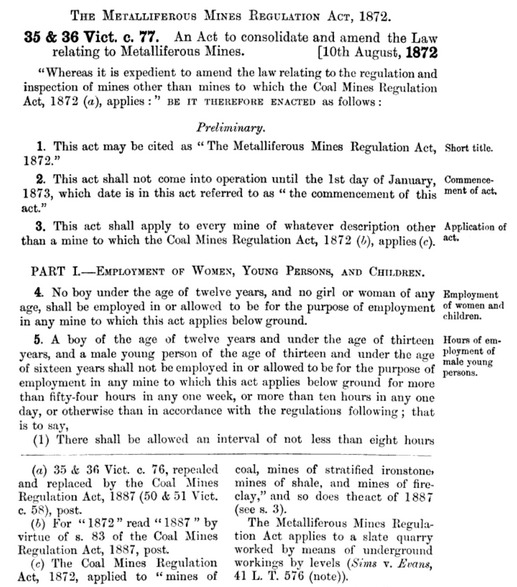
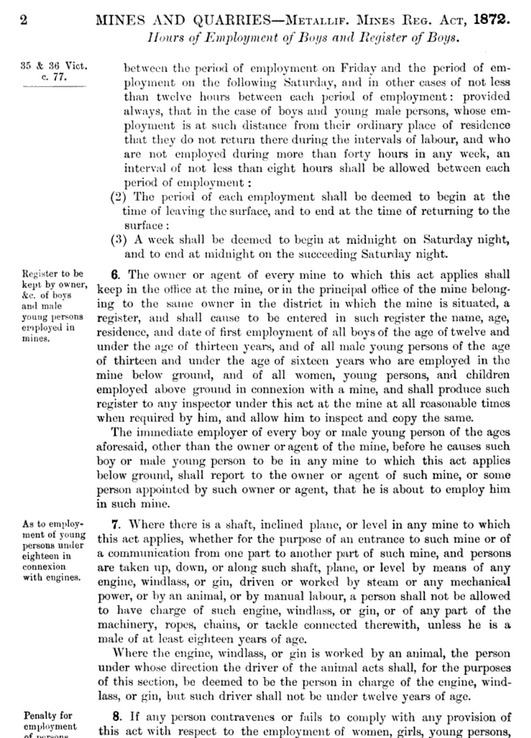
The Education Act of 1870, which applied to England and Wales, made attendance at school compulsory for children between the ages of 5 and 10. For Scotland, an Act was introduced in 1872 that made school compulsory for children between 5 and 13. There were exceptions to these 2 acts, such as for children engaged in apprenticeships or those being appropriately home schooled.
The 1872 Act also made it so boys between 12 and 16 couldn’t work more than 54 hours in 1 week or 10 hours in 1 day. It also required between 8 and 12 hours between periods of employment (defined as starting when they leave the surface and ending when they return to the surface).
It did have provisions for 10 year olds to labor part time where seams were especially thin. At the same time, surface work was regulated, a minimum age of 12 being required for both boys and girls for full-time employment (and 10 years for part-time work).
Norton says in his 2nd letter “Over the last 20 years, I lived like a rat in the gutter”. Based on what we know, he was likely restricted to work above ground until at least age 12, and even afterwards had restrictions on his hours and what he could do and such until at least age 16.

In which case, this comment, based on the context, may have just been referring to him growing up poor. It may imply his father died when he was 8, at which point life became very hard for him, especially as Norton’s mother is never referenced. As I discussed in a previous post, with how rare divorce was, Norton’s mother is more likely to be dead.

#idv#identity v#norton campbell#prospector#Fool's Gold#fools gold#idv norton#identity v norton#idv prospector#identity v prospector#idv fools gold#identity v fools gold#idv fool's gold#identity v fool's gold#sirenjose analyses and theories
124 notes
·
View notes
Text
On Sept 20th we venerate Ancestor & Hoodoo Saint John Henry on the 153rd anniversary of his passing 🕊
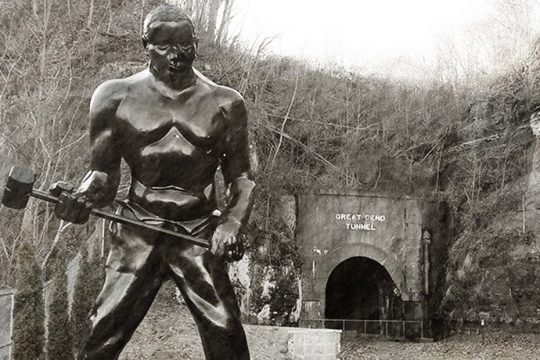
An icon of Hoodoo Folklore & History, John Henry - aka the Steel-Driving Man - embodied the otherworldly strength & will that defied physics, expectation, & the harsh conditions of his time. He is a symbol of Black Power as an unbreakable spirit of resistance and protest.
John Henry was indeed a real man behind the lore of his legend. Though there is still much debate as to who was THE John Henry among many possibilities. As it stands, most scholars believe he was born enslaved in VA in 1840’s, later emancipated after the Civil War. He stood at 6ft tall, 200lbs - a true giant of his time. He carried a beautiful baritone voice & played the banjo. That would make him the 19yr old who was convicted of theft in a VA court in 1866. For his alleged crime, he was sentenced to 10 years in the penitentiary & put to work building the C&O Railroad during the Reconstruction Era.
In the February 1870, the legend of John Henry was born along the C&O Railway at Big Bend Mountain near Talcott, WV - when over 1,000 railroad workers began drilling the Great Bend Tunnel where the Greenbrier River makes a seven-mile meander around the mountain. John Henry was a "free Negro" hired as a Steel-Driver on the C&O Railway. He & his counterparts were saddled with the gruesome task of hammering steel drills into rock to holes for explosives to cut a 6,450 ft-long tunnel through the mountain. Railroad work was hard; long hours of grueling labor, dangerous at times, for little money.
Holes were drilled into the layers of rock using a hand drill & hammer, then filled with powder & blasted in order to make the rock small enough to remove from the tunnel. The drill was held by a “Shaker” - tasked with turning it slightly after each blow & shake it to flip the rock dust out of the hole. The “Steel Driver” swung the hammer as hard & as often as he could, pounding the drill into the rock. John Henry was prolificly known as the strongest, fastest, & most powerful man working on the railroad.

One day, the C&O railroad company bought a steam drill. It was said that the steam drill could drill faster than any man on earth. This sparked the age-old debate & challenge of Man-versus-Machine. John Henry immediately volunteered to go up against the machine to prove that the Black worker could drill a hole through the rock farther & faster than any drill could.
John Henry wielded two 10-14lb hammers, one in each hand. He pounded the steel drill so hard & fast that he drilled a 14ft hole into the rock. The steam drill only reached 9ft. John Henry held up his hammers in triumphant victory. Nearly a thousand railroad workers shouted & cheered his name. So much so that it took them a while before realizing that John Henry was tottering. Exhausted, he crashed to the ground with his hammer at his sides. It is said that the crowd went dead silent as the foreman rushed to his side. John Henry had passed away from exhaustion due to bursted blood vessels in his brain.
The Great Bend Tunnel was eventually completed on September 12th 1872, & remained in service until 1974. A life-sized, 750lb bronze statue of his likeness was erected on Dec 28th 1972 - on the 100th anniversary of the completion of the Great Bend Tunnel. Barbed wire was placed around the statue for many years to combat vandalism of white paint being thrown on it, gun shots to the face and torso, etc.

Sadly, no one knows where John Henry was buried. Some say his likeness can be found carved into the rock inside the Big Bend Tunnel. Others say if you walk to the darkest edge of the tunnel, you can still hear the sound of two 10-14lb hammers drilling their way to victory.
"If I can't beat this steam drill down, I'll die with this hammer in my hand!"- John Henry, as told from The Ballad of John Henry.
John Henry's choosing to go up against the steam drill was not about the challenge in and of itself. It was about proving that the body & spirit of the Black man could NOT be broken. Especially while living in such hard, grueling times. Our livelihoods were at stake & our future was even more uncertain.
Thus, he is forever immortalized in the hearts & minds of our people as symbol of the blood, sweat, & tears that drench the C&O railway by Black railroad workers of the past/present. A beacon for those who lost their lives laboring under such dangerous occupation conditions. The lore of his legend (and the lives of Black workers lost) lives on in oral tradition through story, ballads, Blue's, & work songs from coast to coast. These songs and tales did more than transform John Henry into a folk hero, they reminded us to "slow down or die", which became a tool of resistance & protest among railroad workers.
John Henry was a legend turned symbol among the Black populace of the time. And an Ancestor turned Saint for us those of Hoodoo Culture.
We pour libations & give him💐 today as we celebrate him for his unbreakable spirit, unparalleled strength, & defiance against a system that see us all perish beneath its heel.
Offering suggestions: tobacco smoke, libations of dark liquor, railroad dirt (especially from the C&O railway tunnel/line), & sing/play ole rwork songs and ballads to his name.
‼️Note: offering suggestions are just that & strictly for veneration purposes only. Never attempt to conjure up any spirit or entity without proper divination/Mediumship counsel.‼️
#hoodoo#hoodoos#atr#atrs#the hoodoo calendar#Hoodoo Folklore#Hoodoo History#Hoodoo Saints#hudu#john henry#steel driving man
116 notes
·
View notes
Text

Naiche - Chiricahua Apache
Naiche 1856-1919
Naiche, the youngest son of Cochise, was born in 1856. His mother, Dos-teh-seh, was the daughter of Mangas Coloradas. As a young man he took part in raids on white settlers and in 1872 was with his father when he met Brigadier General Oliver Howard. This resulted in the establishment of the Chricahua Reservation in Arizona ... Taza, Cochise's older son, became chief when his father died in 1874. Two years later Taza died and Naiche became the leader of the Chiricahuas Apaches ... In September 1880, Naiche joined Geronimo and Juh in an attempt to lead their people from the San Carlos Reservation into the Sierra Madre. However, in 1883 General George Crook managed to persuade the Apaches to return to Arizona ... Naiche and Geronimo broke out again in May 1885. Once again General Crook was sent after them. Naiche lived in the Sierra Madre until he was caught by Crook in September, 1886. Natchez now joined the all-Indian "I" Company, 12th Infantry at Fort Sill, Oklahoma ... In 1897 Naiche worked as a scout for Captain Hugh Scott and the 7th Cavalry ... After leaving the army he moved to the Mescalero Reservation in New Mexico ...
Naiche died on 16th March, 1919
120 notes
·
View notes
Text
La Fayette in Franklin, Episode 3

This episode finally brings us the battle of Brandywine – and although there were some details in La Fayette’s storyline that I found … questionable, I really like the depiction of the battle itself. Wars and battles are not pretty, they are gruesome, dirty, bloody events that produce no shortage of human suffering. In Franklin, we see all thi; people being afraid and alone, horribly injured and in pain.




La Fayette transport and experience in the hospital are a bit overromanticized here. Accounts vary somewhat but we know that La Fayette remained with his troops for a long time, his wound was first dressed with a sash, and later Dr. Cochrane on behest of George Washington looked after La Fayette’s injury. He was with his aide-de-camp, Gimat, and at one point future-president James Monroe also made an appearance. While it certainly was a scary and painful experience for La Fayette, it nonetheless was much more “pleasant” than depicted here. It is true however, that Washington made sure, La Fayette was properly treated.


The remark about being “honored” with a bullet by the “English gentleman” is taken directly from a letter to his wife from September 12, 1777 that we will later have a look at. The “I hope you don’t eat me”-remark on the other hand was a missed opportunity that could have been fixed with half a sentence more text. As the story goes, La Fayette was placed upon what was formerly a dining table to be treated. When the officers entered, he remarked that they looked hungry and jokingly asked not be eaten, because he was the only edible dish upon the table.



The episode builds up suspense by suggesting to the viewer that La Fayette died in battle. Here is an account of the same time periode by La Fayette’s wife Adrienne:
But shortly afterwards we heard that M. de Lafayette had been wounded at the battle of Brandywine. I need not say what were my mother’s feelings on hearing such intelligence. She succeeded in keeping from me the report of his death which was spread about at that time (…).
Mme de Lasteyrie, Life of Madame de Lafayette, L. Techener, London, 1872, p. 50.
The battle of Brandywine and La Fayette’s involvement were a matter of great interest and as Adrienne describes, there were reports of his death – but I still think that the show overdramatized the situation by presenting it as if each and every single person - the court, his family and friends, the Americans - believed without a doubt that La Fayette had died. There were conflicting reports but La Fayette himself wrote his own account in the letter to his wife as quickly as possible. The battle of Brandywine as was also by far not the only time accounts of La Fayette’s death were making the rounds.


La Fayette friends (Noailles, Ségur and Temple) mourn La Fayette’s passing at their club. The scene admits that La Fayette could be a bit awkward and too serious at times. At first, I really liked this inclusion because it painted a truer picture – however, the longer I thought about it, the more I dislike it; or, better put, thought it needed just one or two sentences more as explanation. I believe the scene was written with a passage from the Memoirs of the Count de Ségur in mind:
At every period of life, and, above all, in his youth, La Fayette displayed a cold and grave exterior, which sometimes gave to his demeanor an air of timidity and embarrassment, which did not really belong to him. His reserved manners, his silent disposition, presented a singular contrast to the petulance, the levity, and the ostentatious loquacity of persons of his own age; but, under this exterior, to all appearances so phlegmatic, he concealed the most active mind, the most determined character, and the most enthusiastic spirit.
Count de Ségur, Memoirs and Recollections, Boston, 1825, p. 85-86.
Ségur, La Fayette’s long and dear friend (and uncle by marriage) describes here the duality of La Fayette’s character. In the previous paragraph he even somewhat mocks La Fayette’s family and in-laws for not knowing him as well as he does. Still, show-Ségur fails to look “under the exterior” as his real-life counterpart put it. Anyway, what depiction of La Fayette would be complete without the infamous dance between La Fayette and French Queen Marie Antoinette?

The solemn scene is soon resolved, and the viewer learns that La Fayette is indeed fine. While the scene between Noailles, Ségur and Temple is incredibly touching, there is one inaccuracy. Temple mentioned that La Fayette had been made a General. La Fayette had been promised the rank of Major General by Silas Dean in late 1776/early 1777 before setting sail. Now, you could argue that prior to Brandywine this rank was purely symbolic and that after Brandywine La Fayette received more and more of the actual powers and responsibilities of a Major General – but at least on paper he had always been a General.


The show cuts to La Fayette in Philadelphia. Now, I have no idea why he is alone in a tent and does not know where he is – this very much did not happen to the real La Fayette. I am, however, more than willing to forgive the show this, because it presented us with this character.


At first glance this is just some girl/young women, right? In my head (and the show does not contradict me here) this lady is Elisabeth ‘Liesel’ Boeckel. She was one of La Fayette’s nurses, when La Fayette stayed for 29 days in her father house in Bethlehem, Philadelphia to recover from his injury. Her nephew later wrote in his diary that Lisel’s father feared she would “form an intimacy” with La Fayette. La Fayette’s stay in Bethlehem and the towns past and present reception of him is very interesting and worth a post on its own.
The letter Temple reads to Franklin is inspired by a letter La Fayette wrote to his wife on September 12, 1777, the day after the battle. I highlighted the parts that were adapted for this episode.










I send you a few lines, dear heart, by some French officers, my friends, who came here with me but have not obtained positions and are returning to France. I shall begin by telling you that I am well, because I must end by telling you that we fought in earnest yesterday, and we were not the victors. Our Americans, after holding firm for a considerable time, were finally routed. While I was trying to rally them, the English honored me with a musket shot, which wounded me slightly in the leg. But the wound is nothing, dear heart; the ball hit neither bone nor nerve, and all I have to do for it to heal is to lie dear heart, that you will not worry; on the contrary, you should be even less worried than before, because I shall now be out of action for some time. I intend to take good care of myself; you may be sure of that, dear heart. This battle will, I fear, have unpleasant consequences for America; we must try to repair the damage, if we can. You must have received many letters from me, unless the English are as hostile to my letters as to my legs. I have received only one from you so far, and I long for news. Farewell. They won't let me write longer than this. For several days I have not had time to sleep. Last night was spent in our retreat and in my journey here, where I am very well cared for. Let all my friends know that I am in good health; give a thousand tender respects to Mme d'Ayen, and a thousand compliments to my vicomtesse and my sisters. These officers will leave soon; they will see you-how fortunate they are! Good night, dear heart, I love you more than ever.
Idzerda Stanley J. et al., editors, Lafayette in the Age of the American Revolution: Selected Letters and Papers, 1776–1790, Volume 1, December 7, 1776–March 30, 1778, Cornell University Press, 1977, p. 108-110.
It should be said, that in likelihood neither Temple nor Franklin saw this letter and Franklin did not use the letter for a publication. Nonetheless, after the battle of Brandywine La Fayette was heralded a hero and it was the first step in crafting the image we still associate with him today.


#marquis de lafayette#la fayette#lafayette#french history#american history#american revolution#letter#history#benjamin franklin#george washington#1777#adrienne de lafayette#adrienne de noailles#william temple franklin#tv series#franklin apple tv#elisabeth 'liesel' boeckel#gimat
13 notes
·
View notes
Text

Comic from The Days Doings, England, September 14, 1872
12 notes
·
View notes
Text
Timeline for Lies of P
Disclaimer: This is a fan-made timeline of Lies of P for my fanwork Blue Butterfly Record with the assumpting that the game itself takes place in the middle of the Belle Epoque, with the events of the game happening shortly after the release of Frank Baum's The Wonderful Wizard of Oz, published for the public on September 1st, 1900. This will cover 40 years before the game itself by my estimation, and some major events loosely before the events of the game.
1493: Phillipus 'Giangio' Paracelsus and his twin brother are born.
1514: Paracelsus achieves immortality via research into the homunculi - his brother, believing him dead, takes his place.
1674: A descendant of Antonio Corea is found to be a Listener, and is converted into the Gold Coin Fruit Tree after being brought to what would eventually be Krat.
1853: Giuseppe Geppetto is born.
1854: Valentinus Monad is born.
1857: Camille is born.
1860's
1861: The Casati Act is passed, requiring mandatory education.
1867: The Path of the Pilgrim is made.
1869: Fearing the advancement of war between the Papal States and Italian troops, the Alchemists left for safer territory and landed in Moonlight Town.
1869: Simon Manus is born.
1870's
March 1870: The Alchemists discovered Kroud and Ergo underneath Moonlight Town after an Alchemist (later revealed to be a Listener) heard the Ergo.
July 1870: After reports of Ergo's power are discovered, the Alchemists found the City of Krat and began to build.
September 1870: Rome becomes the Capital of Italy.
1871: Lorenzini Venigni is born.
1872: Hotel Krat is purchased by Antonia.
1873: Geppetto moves to Krat and invents the first 'Puppets'
1874: Sophia Monad is born.
January 1877: Romeo "Lampwick" Marino is born.
December 1878: Carlo Geppetto is born on New Year's Eve. During childbirth, Camille C. dies giving birth to her son.
1880's
1880: Venigni makes Pulcinella under his parent's supervision.
1881: Free education is established in France.
1881: France introduces Electricity in the Universal Exhibition of 1881
1881: Carlo is turned over to St. Frangelico's Church for daycare, and handed to a maid puppet in the likeness of Camille after.
July 1881: Storia di un burattino begins publication, and Carlo is read the story by Camille every week.
1881: Camille's ego awakens, and she saves Carlo from falling from a great height. She is taken by the alchemists, leaving Carlo to be placed back in Geppetto's care.
1882: By popular demand, Storia di un burattino is revived for serialization.
1882: Secular education is made mandatory in France.
1883: The Venigni parents are killed by Arlecchino.
1883: The Adventures of Pinnochio are published - a signed first-edition book is given to Carlo.
1884: After a dispute with the Monad Charity House, Carlo is enrolled as a boarding student with tuition to be paid on the first of every month.
1887: Fearing the potential dangers of Paracelsus' influence, Geppetto attempts to murder him.
1890's
1890: Paracelsus returns to Krat under the assumed name of Giangio.
November 2nd, 1892: The Blue Butterfly Record is played for the first time.
December 1892: Romeo graduates late due to a postponed exam due to a broken arm, but remains at the Monad Charity House to stay with Carlo.
January 1893: Romeo's Father Francesco, owner of the Red Lobster Inn, is the first known death of the Petrification Disease. After his death, his most senior employee Maria takes charge.
January 1893: The Tuition Incident takes place.
May 1893: Carlo resolves the Tuition Incident, and successfully graduates as the first person to complete all three Specialties (Stalker, Workshop Technician, Alchemist) with a distinction in Ergocraft. Geppetto does not show up for his graduation.
August 1893: The Petrification Disease Quarantine Zone is established.
1894: The Rose Estate Incident happens; Sophia Monad goes missing, and Romeo, Carlo, and Gemini are all declared dead, among others.
1895: Geppetto finds out Simon Manus is responsible for Carlo's death and breaks from the Alchemists
1896: The first attempt to craft the P-Organ, the Nameless Puppet, fails.
1896: 'Giangio' delivers the Arm of God to the Alchemists anonymously.
1896: The first Nameless Puppet fails.
1897: The Black Rabbit Brotherhood starts
1898: Cecile steals the Arm of God and hides it deep in the Malum District. This resulted in the first mass outbreak since the Rose Estate Incident.
1899: Pino is made, fails, and is set aside while a new power source is looked for.
1990's
1990: The Puppet Frenzy begins, two weeks before the Grand Exhibition is scheduled to start.
September 1st, 1990: The Wonderful Wizard of Oz is published, and Pino is awakened.
(Canon) September 1st-3rd, 1990: Lies of P takes place.
(Blue Butterfly Record) September 1st-18th: Lies of P takes place, Real Boy Ending, Max Humanity [redacted]
November 2nd, 1900: Sophia expends the last of her Ergo to create the Blue Butterfly Record.
November 1st, 1901: The Real Boy Carlo Geppetto discovers the Blue Butterfly Record.
December 31st, 1901: Carlo Geppetto celebrates his 23rd birthday, and plays the Blue Butterfly Record before leaving Krat for good.
January 1st, 1902: All of Sophia Monad's Ergo is expended to send Carlo Geppetto (in all his forms) back in time to November 2nd, 1982, starting the events of the Blue Butterfly Record.
#lies of p#lies of p carlo#lies of p geppetto#lies of p giangio#Simon Manus#carlo geppetto#Sophia Monad
16 notes
·
View notes
Text



On September 23, 1872, the Rockefeller Fountain was turned on in Como, Italy.
#Rockefeller Fountain by Biagio Catella#turned on#23 September 1872#Bronx Zoo#the Bronx#New York City#summer 2018#travel#original photography#vacation#tourist attraction#landmark#architecture#cityscape#USA#US history#anniversary#public art#lawn#nature#flora
2 notes
·
View notes
Text





Space Shuttle Challenger rollout ceremony at Rockwell International's Palmdale Facility.
Date: June 30, 1982

"Commander Paul J. Weitz (far right) and the other NASA astronauts who will fly the new space shuttle Challenger — from left, Dr. Story Musgrave, pilot Karol J. Bobko and mission specialist Donald H. Peterson — attend turnover ceremonies, at Rockwell International's final assembly site in Palmdale, Calif."

"She is named after HMS Challenger, a British corvette that was the command ship for the Challenger Expedition, a pioneering global marine research expedition undertaken from 1872 through 1876. The Apollo 17 Lunar Module, which landed on the Moon in 1972, was also named Challenger."
-Information from Wikipedia: link, link



She was built as Static Test Article 099 (STA-099) and was a prototype of the light weight orbiter (OV-103 to OV-105). It underwent vibration tests designed to simulate entire shuttle flights, from launch to landing. When it was determined the design changes learned from STA-099, the Construction of Columbia and the Approach and landing tests meant the Enterprise (OV-101) would be expensive to refit into an operational orbiter. It requires a complete tear down and rebuild to bring it up to the latest design specs and delay the completion of Discovery and Atlantis by 12 months. It was found it would be cheaper to refit STA-099 and only delay the completion of the other two orbiters by 6 months.
Lessons learned from the first flight of Columbia (OV-102) led to her being 2,200 pounds (1,000 kilograms) lighter than Columbia, although still she was 5,700 pounds (2,600 kilograms) heavier than her sister Discovery (OV-103). Upon completion, She possessed fewer thermal protection system tiles and carry 2,500 lb (1,100 kg) more payload than Columbia.
Construction date milestones (STA-099):
1972 July 26: Contract Award to North American Rockwell
1975 January 6: start long lead fabrication of aft-fuselage
1975 November 21: start structural assembly of crew module
1976 February 16: start fabrication of forward-fuselage
1976 June 14: start structural assembly of aft fuselage
1976 August 2: start structural assembly of forward-fuselage
1976 October 1: start assembly of vertical stabilizer, Fairchild-Republic
1976 October 1: start assembly of wings, Grumman
1976 October 16: mid-fuselage on dock, Palmdale
1977 January 25: aft-fuselage on dock, Palmdale
1977 January 28: simulated crew module on dock, Palmdale
1977 March 16: wings on dock, Palmdale
1977 April 1: lower forward-fuselage on dock, Palmdale
1977 April 6: upper forward-fuselage on dock, Palmdale
1977 April 1: vertical stabilizer on dock, Palmdale
1977 May 20: forward landing gear doors on dock, Palmdale
1977 May 26: aft payload bay doors on dock, Palmdale
1977 May 31: body flap on dock, Palmdale
1977 July 22: forward payload bay doors on dock, Palmdale
1977 September 30: start of Final Assembly
1977 September 30: mating of vertical stabilizer, Palmdale
1977 November 7: forward RCS module on dock, Palmdale
1978 February 10: completed final assembly
1978 February 14: rollout from Palmdale
Testing as STA-099:
1978 February 14: delivery to Lockheed for testing
1978 August 11: complete test preparation, Lockheed
1978 August 14: start coefficient tests
1978 September 29: finished coefficient tests
1979 August 6: complete limited testing
1979 October 5: complete setup and thermal tests
1979 November 7: delivery to Rockwell for conversion to Challenger (OV-099)
Conversion date milestones (OV-099):
1979 January 2: start long lead fabrication of crew module
1979 January 5: contract Award to Rockwell International, Space Transportation Systems Division
1979 June 21: start structural assembly of crew module
1979 November 7: delivery from Lockheed, Palmdale
1979 December 7: demate payload bay doors
1979 December 14: demate body flap
1979 December 21: demate elevons
1980 January 18: vertical stabilizer returned to Fairfield-Republic for reworked
1980 January 25: body flap returned to Downey facility for reworked
1980 January 25: payload bay doors returned to Tulsa for reworked
1980 January 28: start instrumentation removal and prepare mid-fuselage for reworked, Palmdale
1980 February 1: complete aft-fuselage demate Palmdale
1980 February 1: aft-fuselage on dock, Downey
1980 February 1: elevons on dock to be reworked, Grumman
1980 February 4: start instrumentation removal and prepare wing for modification, Palmdale
1980 February 8: demate forward RCS module, Palmdale
1980 February 15: complete demate upper forward fuselage, Palmdale
1980 February 23: upper forward fuselage on dock to be reworked, Downey
1980 March 21: forward RCS module on dock to be reworked, Downey
1980 May 30: complete preparation lower forward fuselage modification, Palmdale
1980 September 1: start body flap modification, Downey
1980 November 3: start of final assembly
1980 November 3: start initial system installation crew module, Downey
1980 November 21: complete modification lower forward fuselage, Palmdale
1980: December 12: complete rework aft-fuselage, Downey
1981 February 2: start initial system installation forward RCS module, Downey
1981 February 13: left outboard elevon on dock, Palmdale
1981 March 1: body flap on dock, Palmdale
1981 March 27: vertical stabilizer on dock, Palmdale
1981 March 30: elevon rework complete, on dock, Palmdale
1981 July 2: upper forward-fuselage on dock, Palmdale
1981 July 10: payload bay door on dock, Palmdale
1981 July 14: crew module on dock, Palmdale
1981 July 17: complete body flap modification, Downey
1981 July 21: aft-fuselage on dock, Palmdale
1981 July 24: body flap on dock, Palmdale
1981 October 23: complete airframe modifications, Palmdale
1981 October 23: completed final assembly
1981 October 26: start initial subsystems test power-on, Palmdale
1981 November 2: start initial subsystems test, Palmdale
1982 January 29: complete initial subsystems test, including Delta F, Palmdale
1982 January 31: forward RCS module on dock, Palmdale
1982 February 21: right-hand OMS/RCS pod on dock at Palmdale for thermal protection system installation
1982 March 3: left-hand OMS/RCS pod on dock at Palmdale for thermal protection system installation
1982 April 16: complete subsystems test, Palmdale
1982 April 30: complete final acceptance test, Palmdale
1982 June 21: complete configuration inspection, Palmdale
1982 June 30: rollout ceremony from Palmdale
1982 July 1: overland transport from Palmdale to Edwards
1982 July 5: Delivery to KSC
NASA ID: 2650-A, 13-219
Photo from the Phoenix Aviation Research Facebook page: link
source, source, source, source
Posted by Stephen Isherwood on the "Space Shuttle Challenger - The Legacy and History of OV-099" Facebook group page: link
#Space Shuttle#Space Shuttle Challenger#Challenger#OV-099#Orbiter#NASA#Space Shuttle Program#rollout#June#1982#Rockwell International#Palmdale#California#rollout ceremony#long post#my post
133 notes
·
View notes
Text
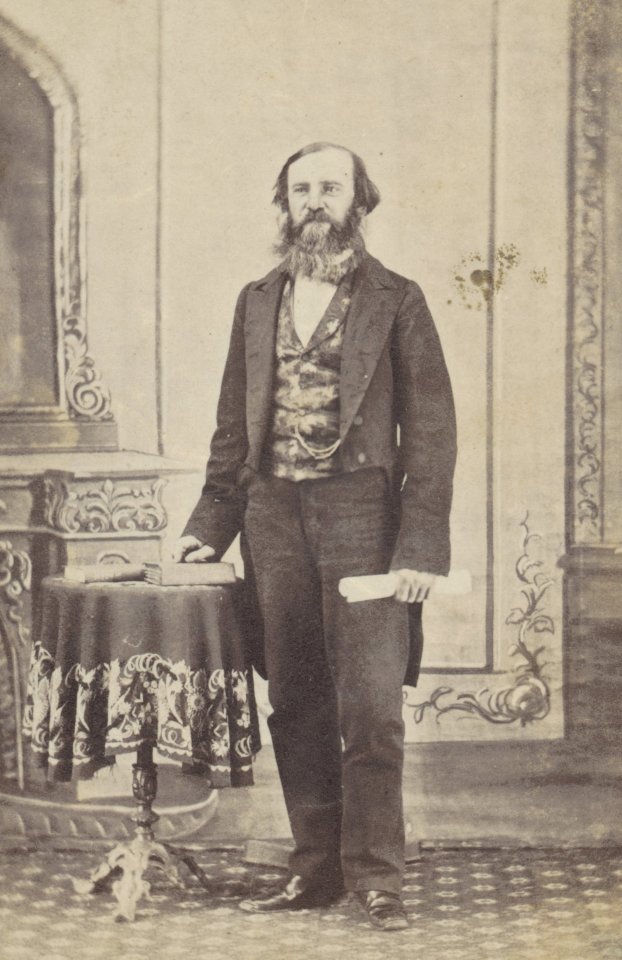
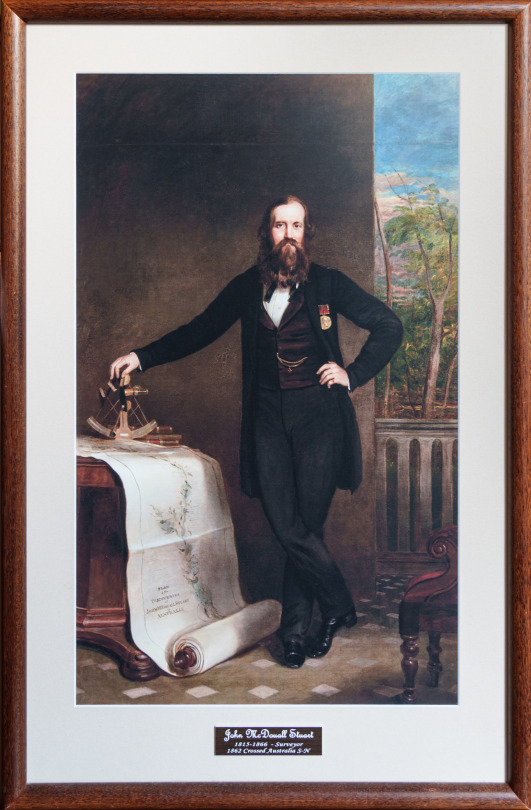
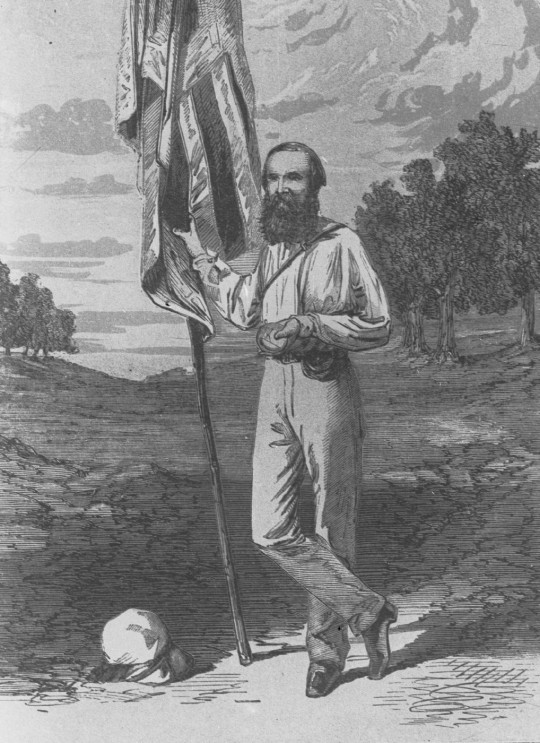

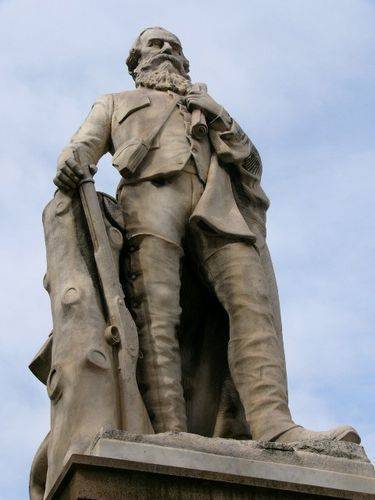
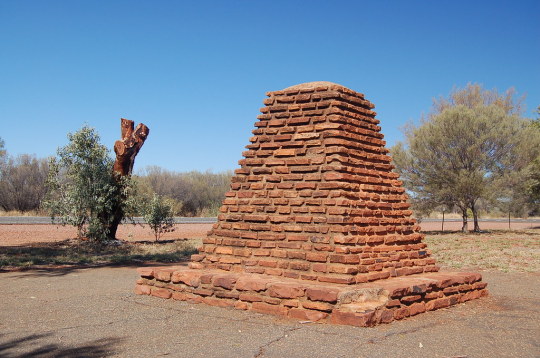
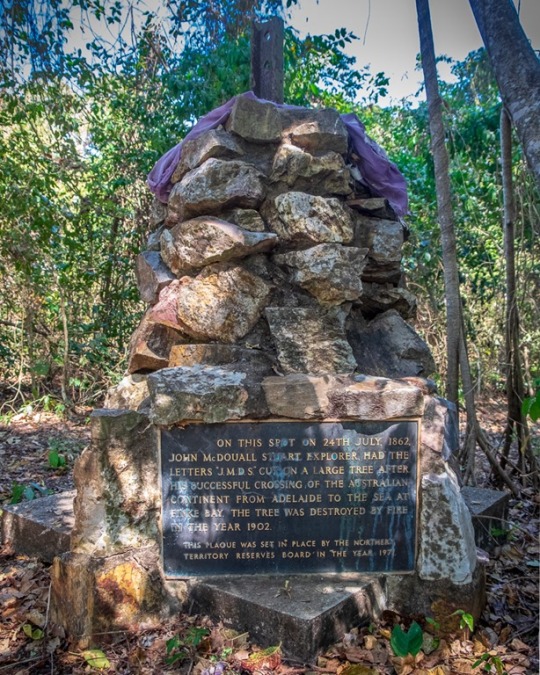
On September 7th 1815, explorer John McDouall Stuart was born in Dysart, Fife.
Descended from a family steeped in military service, Stuart was born in in a sixteenth-century home which now houses a museum in his honour, as seen in the pic. He was the son of army captain William Stuart and his wife Mary (née McDouall). Orphaned in his early teens, he attended the Scottish Naval and Military Academy, Edinburgh, and graduated as a civil engineer.
At the age of 23 he embarked on the Indus from Dundee, arriving at Holdfast Bay, South Australia, in January 1839. He entered the Government Survey Department and, despite primitive conditions in survey camps, found that nomadic life in the bush appealed to him. A man of small stature, his life became a constant battle against ill health and poverty. Assigned as draughtsman for the 1844-46 expedition of Captain Charles Sturt into the interior, Stuart gained valuable experience and received his leader’s full approbation. Sturt’s failure to reach the centre of the continent inspired Stuart’s later achievements.
Returning to Adelaide in January 1846, Stuart was incapacitated with scurvy for twelve months and moved to Port Lincoln for health reasons, while recovering he worked for fellow Scot and shipmate James Sinclair on his properties and tutored the Sinclair children.
In 1854 William Finke and the Chambers brothers, James and John, engaged him to survey leases and prospect for minerals in the northern Flinders Ranges. Between May 1858 and January 1860 Stuart led three expeditions into the Lake Eyre region, seeking new grazing lands and minerals for his sponsors.
In contrast to Sturt, Stuart travelled quickly with limited supplies. Horses were his only means of conveyance. On his first attempt to cross the continent, he reached the geographical centre of Australia on 22nd April 1860, accompanied by two companions and twelve horses --- a feat later described as ‘the greatest and pluckiest exploration ever accomplished’. He tried again the following year but it was not until 1862 that he finally made it to the northern shore.
In poor health Stuart returned to England in 1864, nearly blind and with a broken constitution. He died on 5th June 1866, a forgotten hero. He was buried at Kensal Green Cemetery, London, with a memorial stone erected by his sister Mary.
As a result of Stuart’s expeditions, the nature of the Red Centre was revealed, South Australia gained control of and settled the Northern Territory, and vast areas of the interior were opened up for European settlement. In 1872 the Adelaide-to-Darwin Overland Telegraph Line was completed along Stuart’s route.
His statue was erected in Victoria Square, Adelaide in 1904 and Central Mount Stuart, the Stuart Highway and Stuart Range are named in his honour. The John McDouall Stuart Society was founded in 1964 by descendants of his companions to perpetuate his name and achievements.
A second statue of Stuart can be found in Alice Spring. The statue has been hounded by controversy since it was gifted to the Alice Springs Town Council in 2010, with some saying the work is culturally insensitive. Protests accuse him of not asking permission to enter the land and of killing Arrernte people."You came to Mount Hay and you killed our mob," a letter from Aboriginal elders said. "You went to Attack Creek and you killed more of our mob. This is murder and we can't forget it." it continued.
The Australian Aboriginal singer Warren H Williams also spoke at a protest rally, mocking the size of the gun and calling for the statue to be removed.
"This fella has destroyed both Arrernte and Warramungu [people]...look at the statue, it's a big gun," he said.
"They put a statue up of him, but never asked anybody, even the white people in this town if they can put it up..."
There are numerous memorials to Stuart around South Australia.
8 notes
·
View notes
Text




Anže Janosovski marries Mateja Pirjevic in the ceremony of the season in Ljubljana, Slovenia. Pirjevic was given away by her father, Jaka Pirjevic.
Janosovski is the oldest son of Nejc and Katarina Janosovski. Janosovski plans to take his new bride to start a life in the United States.
Mateja Pirjevic was born in Koseze to Rene and Asja Pirjevic on March 8, 1872. Anže Janosovski was born in Mirje in September 12, 1871. They are both the eldest children of their families, Mateja being the oldest of thirteen and Janosovski the oldest of six.
The two are taking a ship out of Liverpool, later this fall, and should reach their homestead in the Pacific Northwest by Spring 1890.
#janleg#ts4 legacy#decades challenge#decade: 1890#decades legacy#sims 4 decades#decades#the sims 4#sims 4#ts4#ts4 gameplay#ts4 historical#simblr#janleggen1
9 notes
·
View notes